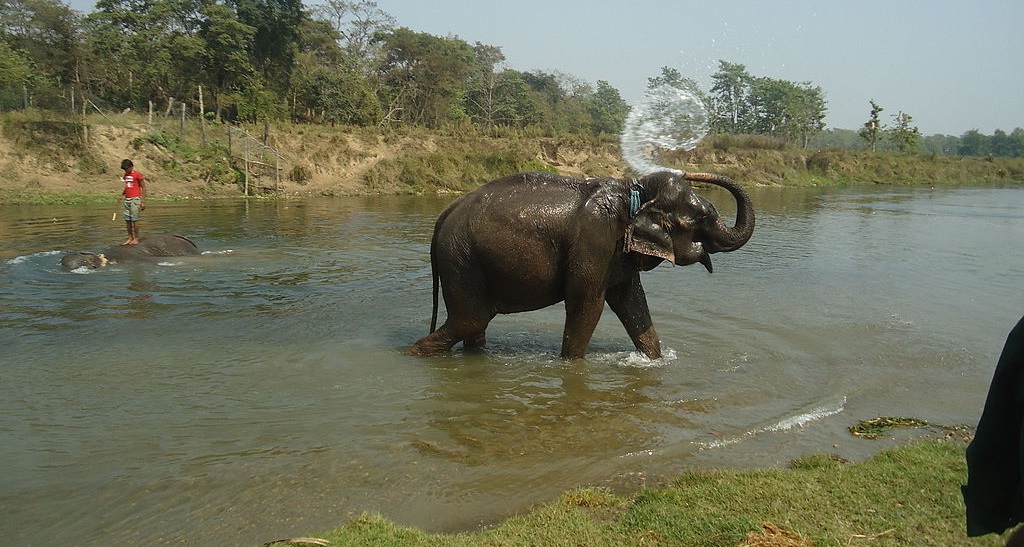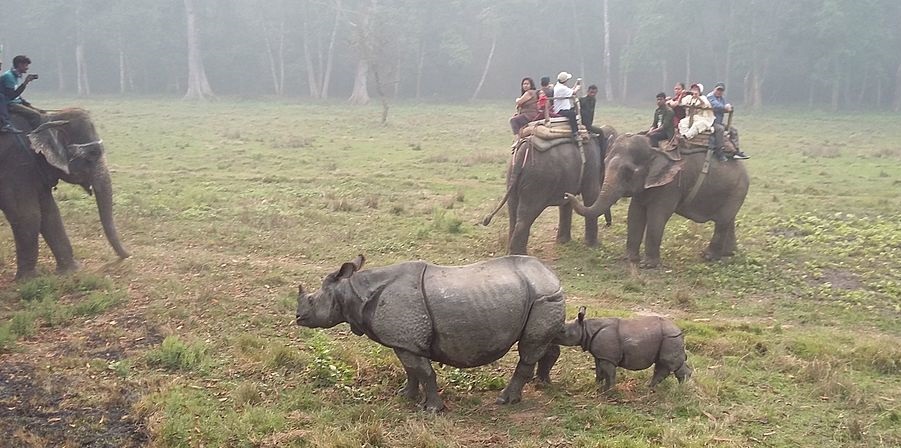Chitwan is the combination of two literal Nepali words: chit or Chita meaning heart and wan or ban meaning jungle. Thus, the name Chitwan has its meaning as ‘The heart of Jungle’. Lying on the foothills of Himalayas, Chitwan has a wide range of flora and fauna and home to one of the last population of one-horned Asiatic rhinoceros. Established in 1973, Chitwan National Park is the first national park in Nepal.
Its area during the time of its establishment was 544 sq km. It was later extended to 932 sq km. It is located in the subtropical Inner Terai lowlands of south-central Nepal in Nawalparasi, Parsa, Makwanpur, and Chitwan district. These districts cover 3.54%, 15.45%, 6.97% and 74.04% of total area of the park. The Chitwan National Park consists a Ramsar site: a wetland of international importance – Beeshazar and associated Lake (twenty thousand lake) within its buffer zone. UNESCO listed the National Park in World Heritage Site in 1984.
Floral and Faunal Diversity
The tropical broadleaf forest dominated the floral composition of the Chitwan National Park with the majority of about 70% Saal (Shorea robusta) trees on moist, well-drained lands. The vegetation is also contributed by grassland, riverine forests and Sal with Chir pine Pinus (Pinus roxburghii). The riverine forest consists of Khair (Acacia catechu), Sissoo (Dalbergia sissoo) and Simal (Bombax ceiba).
The Chitwan National Park is home for a total of 68 species of mammals, 56 species of herpetofauna and 126 species of fish. The park is particularly famous for the conservation of one-horned rhinoceros. Bengal tiger, leopards, sloth bears, fishing cats, wild dogs, wild elephant, and wild boars are some of the mammals inhabiting in the park. The Chitwan National Park is also a wonderful habitat for various bird species occurring all over the country. 543 species of birds were recorded which includes 22 globally threatened species which includes Bengal florican, the vulnerable lesser adjutant, Grey-crowned Prinia, swamp francolin and species of grass warblers. Apart of these 160 migratory species of birds often visit the park in autumn to spend their winter here. The park is also one of the very few sites of a globally threatened spotted eagle. The colorful Bengal pitas and several sunbird species are common visitors during the monsoon.

Weather of the Chitwan National Park
Chitwan experiences a tropical monsoon climate with humidity throughout the year. The temperature of an average 25°C is observed between Octobers to March which is a pleasant time. The wind is cold, and it is the perfect time to see the Great Himalayan Range. March to June is the hot months with a temperature rising in average up to 43°C at maximum. Towards the end of the May, monsoon storm strikes and heavy rain occurs till the mid-September. Rainfall is normally not continuous; the days are hot and dry as well as wet.
Best time to visit the Chitwan National Park
The sky above Chitwan is comparatively clear from October to March which offers a comfortable climate. However, the local villagers cut the thatch grasses in late January, which provides a greater probability of viewing the animals. You have a chance to see leopard, wild elephant or sloth bear if you are lucky enough. Thus, you can visit the Chitwan National Park at any time of the year. However, around the middle of the June till September, when monsoon begins properly may not probably the time you will prefer due to heavy rain.

How to get from Kathmandu to Chitwan National Park?
Regular flights, as well as buses, are available to ease you for your journey.
Flights depart on a regular basis everyday Kathmandu to Bharatpur Chitwan from 8:00 AM in the morning to 3:30 PM. Buddha Air, Yeti Air, and other companies operate 3 to five flights per day. The flight normally takes around 20 minutes. This option will be the most convenient for you if you have limited time. Kasara, the park headquarters, and Sauraha are the entry points for the Chitwan National Park. Kasara and Sauraha are 24 km and 18 km far from Bharatpur airport respectively.
Tourist, as well as local bus, is available from Kathmandu. You can get a tourist bus from a road named Sorakhutte. The bus leaves at 7:00 AM and you are required to be at the station 30 minutes earlier. A standard tourist bus costs about US8-US10. Deluxe bus costs US10-US20 that includes lunch, Wi-Fi, air condition and maybe a bottle of water. The choice is yours. It is also not necessary to book the ticket in advance. However, if you want to, you can book your tickets through any of the travel agencies. It takes around 6 to 7 hours to reach Chitwan. You can also get a local bus to Chitwan from New Bus Park, Gongabu, and Kalanki. These buses are comparatively cheaper costing Rs 400 to Rs 600. But I am pretty sure you will prefer a tourist bus since they are less comfortable and make you tolerate the frequent stops on the way.

